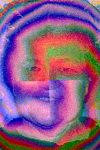
Forgotten by 2012 — Forward to the Past
Seagrove Beach, Florida, USA
2010 June 20 sunset about 19:40 CDT and June 23 sunrise about 5:50 CDT
Or forgetting the recent disaster, if the US government lifts the temporary moratorium and Florida lifts its ban on offshore drilling and begins producing oil products three miles from here, we will have nearby oil accidents.
Or Deer Lake State Park might be forgotten by me if the air becomes so toxic to breathe, that I leave the area and never return. So much for Blessings Beach, seen here on the west (to the right of the stairs down to the shore). Note the black debris along the water here is probably seaweed or peat fragments. On the day I photographed the sunset there were tarballs farther west towards the tall building. For the solstice on June 21 the beach was washed clean by tides and storm. However, some say invisible dispersants are in the water column and oil permeates the sand below.
Early settlers reported a second line of taller sand dunes that previously protected the Emerald Coast. Now gone, lost and largely forgotten.
This scene honors the solstice on June 21. This is the farthest north the sun appears during the year. This is the longest day of the year here in the northern hemisphere of earth and is the first day of summer. I have learned it is more globally correct to call it the northern solstice. One reason is because the calendars of some cultures are not based on months and June has no reference. The solstice that occurs for me in December is best called the southern solstice.
I photographed sunset the night before the solstice, June 20, and sunrise the first morning of visible sunrise, June 23. Since this is a solstice, meaning sun standing still, sunrise and sunset times vary little in the days before and after the solstice. Since I wanted to know where the Sun was, it was not as important to have the exact date. The panorama shows the farthest north points of the Sun's path on the horizon during the year.
March equinox 2010 suns: Food - sun-kissed apple
Lat: 30° 17' 59.88" N
Long: 87° 5' 40.9" W
Precision is: Medium. Nearby, but not to the last decimal.
I needed relatively cloudless skies to see the locations of the sun. The weather forecast for the solstice was bad. The word solstice comes from roots meaning sun standing still. That describes how little the sun rise and set times and location change in the days before and after the solstice. The morning of June 20 looked good until I reached the beach and saw fantastic lightning storms all across the Gulf of Mexico in the south. I backed out. The evening was perfect. As I walked up the beach, I took video of the first tarballs to reach this shore and darkened bird with my little Pentax. See it in the links section. Five people were on the beach but left at sunset as I was turning the camera round and round. It was hot and yellow flies started biting. The large cloud to the north loomed orange overhead with lightning in the distance. I left just in time. Drops were falling when I reached my car.
Opening the photos in Camera Raw, I changed the white balance to "shade" and the exposure to .55. I forgot to do this for the following sunrise set. The photos were not very sharp. Not sure if the lens needed cleaning or my attempt to set a manual focus failed.
The next good day was June 23. I woke at 4 and wrapped in clothes against the flies. Started walking up the beach at 4:35 and was on the ramp at 5:15. It took awhile to position the tripod according to the marks I had left at the sunset shooting. It was peaceful being up with the birds. No flies.



 Tap or click the zoom icon in the bottom right corner of the picture to switch between in-page and fullscreen view
Tap or click the zoom icon in the bottom right corner of the picture to switch between in-page and fullscreen view